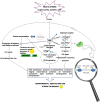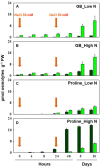Spatial and Temporal Profile of Glycine Betaine Accumulation in Plants Under Abiotic Stresses
- PMID: 30899269
- PMCID: PMC6416205
- DOI: 10.3389/fpls.2019.00230
Spatial and Temporal Profile of Glycine Betaine Accumulation in Plants Under Abiotic Stresses
Abstract
Several halophytes and a few crop plants, including Poaceae, synthesize and accumulate glycine betaine (GB) in response to environmental constraints. GB plays an important role in osmoregulation, in fact, it is one of the main nitrogen-containing compatible osmolytes found in Poaceae. It can interplay with molecules and structures, preserving the activity of macromolecules, maintaining the integrity of membranes against stresses and scavenging ROS. Exogenous GB applications have been proven to induce the expression of genes involved in oxidative stress responses, with a restriction of ROS accumulation and lipid peroxidation in cultured tobacco cells under drought and salinity, and even stabilizing photosynthetic structures under stress. In the plant kingdom, GB is synthesized from choline by a two-step oxidation reaction. The first oxidation is catalyzed by choline monooxygenase (CMO) and the second oxidation is catalyzed by NAD+-dependent betaine aldehyde dehydrogenase. Moreover, in plants, the cytosolic enzyme, named N-methyltransferase, catalyzes the conversion of phosphoethanolamine to phosphocholine. However, changes in CMO expression genes under abiotic stresses have been observed. GB accumulation is ontogenetically controlled since it happens in young tissues during prolonged stress, while its degradation is generally not significant in plants. This ability of plants to accumulate high levels of GB in young tissues under abiotic stress, is independent of nitrogen (N) availability and supports the view that plant N allocation is dictated primarily to supply and protect the growing tissues, even under N limitation. Indeed, the contribution of GB to osmotic adjustment and ionic and oxidative stress defense in young tissues, is much higher than that in older ones. In this review, the biosynthesis and accumulation of GB in plants, under several abiotic stresses, were analyzed focusing on all possible roles this metabolite can play, particularly in young tissues.
Keywords: CMO; ROS; compatible compound; glycine betaine (GB); osmotic adjustment; salinity.
Figures



Similar articles
-
Improved tolerance to various abiotic stresses in transgenic sweet potato (Ipomoea batatas) expressing spinach betaine aldehyde dehydrogenase.PLoS One. 2012;7(5):e37344. doi: 10.1371/journal.pone.0037344. Epub 2012 May 16. PLoS One. 2012. PMID: 22615986 Free PMC article.
-
Glycine betaine and plant abiotic stresses: Unravelling physiological and molecular responses.Plant Sci. 2025 Jun;355:112479. doi: 10.1016/j.plantsci.2025.112479. Epub 2025 Mar 23. Plant Sci. 2025. PMID: 40132665 Review.
-
Rice choline monooxygenase (OsCMO) protein functions in enhancing glycine betaine biosynthesis in transgenic tobacco but does not accumulate in rice (Oryza sativa L. ssp. japonica).Plant Cell Rep. 2012 Sep;31(9):1625-35. doi: 10.1007/s00299-012-1276-2. Epub 2012 May 9. Plant Cell Rep. 2012. PMID: 22569963
-
Isolation and characterization of a novel peroxisomal choline monooxygenase in barley.Planta. 2011 Dec;234(6):1215-26. doi: 10.1007/s00425-011-1478-9. Epub 2011 Jul 17. Planta. 2011. PMID: 21769646
-
Important roles of glycinebetaine in stabilizing the structure and function of the photosystem II complex under abiotic stresses.Planta. 2020 Jan 6;251(2):36. doi: 10.1007/s00425-019-03330-z. Planta. 2020. PMID: 31903497 Review.
Cited by
-
Silicon Alleviate Hypoxia Stress by Improving Enzymatic and Non-enzymatic Antioxidants and Regulating Nutrient Uptake in Muscadine Grape (Muscadinia rotundifolia Michx.).Front Plant Sci. 2021 Feb 10;11:618873. doi: 10.3389/fpls.2020.618873. eCollection 2020. Front Plant Sci. 2021. PMID: 33643333 Free PMC article.
-
Candidate Genes Associated with Abiotic Stress Response in Plants as Tools to Engineer Tolerance to Drought, Salinity and Extreme Temperatures in Wheat: An Overview.Plants (Basel). 2022 Dec 2;11(23):3358. doi: 10.3390/plants11233358. Plants (Basel). 2022. PMID: 36501397 Free PMC article. Review.
-
Metabolomic analyses provide insights into the preharvest rind disorder in Satsuma Owari Mandarin.Front Plant Sci. 2023 Sep 26;14:1263354. doi: 10.3389/fpls.2023.1263354. eCollection 2023. Front Plant Sci. 2023. PMID: 37822340 Free PMC article.
-
GLYCINE betaine and seaweed-based biostimulants improved leaf water status and enhanced photosynthetic activity in sweet cherry trees.Front Plant Sci. 2024 Dec 20;15:1467376. doi: 10.3389/fpls.2024.1467376. eCollection 2024. Front Plant Sci. 2024. PMID: 39759231 Free PMC article.
-
Leaf nutrient content and transcriptomic analyses of endive (Cichorium endivia) stressed by downpour-induced waterlog reveal a gene network regulating kestose and inulin contents.Hortic Res. 2021 May 1;8(1):92. doi: 10.1038/s41438-021-00513-2. Hortic Res. 2021. PMID: 33931617 Free PMC article.
References
-
- Agastian P., Kingsley S. J., Vivekanandan M. (2000). Effect of salinity on photosynthesis and biochemical characteristics in mulberry genotypes. Photosynthetica 38 287–290. 10.1023/A:100726693 - DOI
-
- Allard F., Houde M., Kröl M., Ivanov A., Huner N. P. A., Sarhan F. (1998). Betaine improves freezing tolerance in wheat. Plant Cell Physiol. 39 1194–1202. 10.1093/oxfordjournals.pcp.a029320 - DOI
-
- Ashraf M., Foolad M. R. (2007). Roles of glycine betaine and proline in improving plant abiotic stress resistance. Environ. Exp. Bot. 59 206–216. 10.1016/j.envexpbot.2005.12.006 - DOI
-
- Banu M. N. A., Hoque M. A., Watanabe-Sugimoto M., Islam M. M., Uraji M., Matsuoka K., et al. (2010). Proline and glycinebetaine ameliorated NaCl stress via scavenging of hydrogen peroxide and methylglyoxal but not superoxide or nitric oxide in tobacco cultured cells. Biosci. Biotechnol. Biochem. 74 2043–2049. 10.1271/bbb.100334 - DOI - PubMed
Publication types
LinkOut - more resources
Full Text Sources

